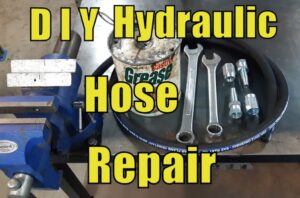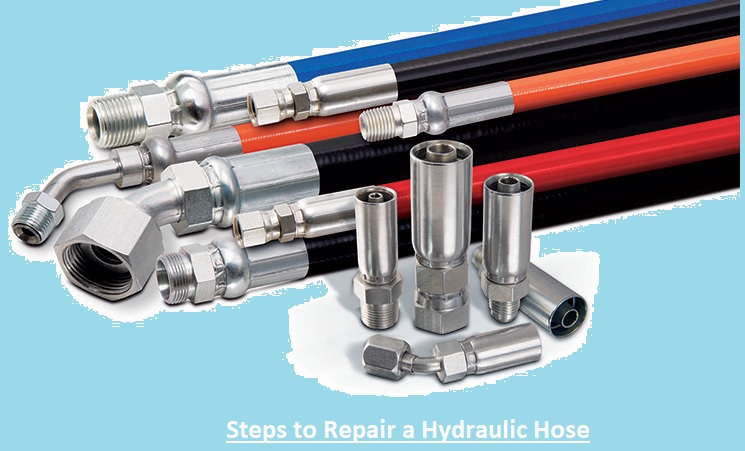Hydraulic hoses are the main component used in industries that help to transfer fluids in hydraulic systems. For longer use, this hose can be damaged and cause leaks and damage the system if not maintained after some time. Different methods used for repairing hydraulic hoses are important safety measures. Here we will cover details for hydraulic hose errors and learn how to repair them.
What are hydraulic hoses?
- Hydraulic hoses Pipes are the main component of a hydraulic system. Hydraulic hoses are small and durable in nature. During working, it can be damaged due to wear and tear with time.
- For accurate working of the machine, it is necessary to work well with hydraulic hoses.
- The working life of a hydraulic hose is less as compared to a hydraulic system, but knowledge of replacing hydraulic hoses is important for the working of hydraulic machinery.
Types of Hydraulic Hose Damage
Damage to the hydraulic hose is important for the working of the hydraulic system and the damaging of the hydraulic system. Here are some types of hydraulic hose damage that occur in hydraulic hoses.
Behind the Hose End Damage
- Where the hydraulic hose connects with the remaining hydraulic system is a common part for finding damage. Since connectors and fittings rub against the hose in a system where high motion exists. Rubbing causes damage.
Local External Damage
- Due to external forces, scratches and other damages, like dents, occur on hydraulic hoses.
External Wear
- Hydraulic hose gets damaged due to abrasion contact with the floor, like during hydraulic cleaning, which is normal.
Long-term Use Damage
- If you are using hydraulic hose for a longer term, there is a need for accurate service and maintenance for safety measures. If not doing maintenance causes damage to hydraulic hoses.
Steps to Repair a Hydraulic Hose
Define Accurate Hose
- Different heavy instruments perform different functions, and each function needed uses a certain value of pressure. Different hydraulic hoses come with different least pressures for one device.
- It is good to define which features those needed for repairing. In some conditions, tubing is made for a certain length and put in a short assembly to make sure that it is cut at the time of repairing.
- Make sure that it is dangerous to replace the wrong base; hydraulic hoses should follow the minimum operating pressure and maximum burst pressure of hoses.
Find damage and minimize Pressure
- Find that hydraulic fluid is leaking through the turning hydraulic unit. After finding the leak, note which type of hydraulic hoses are connected and need to be changed.
- When you get to the point of leaking, replace hydraulic system pressure. Disconnect the damaged hydraulic hose by controlling pressurized air and the hydraulic control neutral position and relieve pressure of the system.
Remove the affected component.
- Now cut the damaged part of the hose. If there is coupling on the end of the hose that is leaking, cut off the faulty part. Clean the area about the cut end of the hose. Clean dust if there exists any that can affect hydraulic fluid.
- Small dust particles damage inner components and cause any serious damage. It is good to make sure that fitting hose cut ends are clean before repairing.
Use an Adapter for Installation
- The hydraulic adapter is used for the installation of the repaired hose. The best is that carry kit that has the required adapter; if required, use the adapter in certain ports to make a solid connection.
- Accurate tightening of the adapter and coupling is important for the repair process.
- Bad torquing can have a bad effect on the hydraulic system. Before applying the torque value, get details from the manufacturers.
Set accurate length.
- Not put the hose assembly in its required location and make sure that the length is enough. The improperly routed hose causes more pressure.
- It is good to have a high hose that is small; that is best for setting an accurate length that provides accurate routing based on the National Association for Hose & Accessories Distribution and manufacturer instructions.
- The hydraulic system faces constant pressure, and the hose is short and has a chance for damage.
- If the hose comes with the required length, set the proper route. It helps the hydraulic system to work well. Different tools used are designed for fitting routing hoses and help hydraulic oil to flow in a free way.
- If there is a need for angled adaptation, connect the angled fitting to provide an accurate position.
- When the angled adapter is connected to the hose assembly end threads on the port
Proper Seal
- Now use threading for the remaining part of the hose assembly and make sure that an accurate seal is made. A small gap in the seal causes an error for the hydraulic system, so double-check the seal before further work.
- Seal must be secure, but avoid high, tight closing. Do not twist the hose for putting it in position. Use a wrench to tighten the fitting and avoid the seal.
Check leaks through fluid circulation.
- In the last hydraulic system, get on and flow oil or any other liquid at low pressure. It helps to find any leaks and affected connections. Through the circulation of hydraulic fluid in low pressure, the remaining air is flushed.
- Air in the system affects the working of the pump and other parts. The hydraulic system works for some time and then again finds leaks. Do not use your hand to check leaks that cause any damage from fluid injection.
- For this purpose, use a sheet. It takes some time to find leaks. Make sure that the system is working well before driving a car or machine.
- For detailed inspection and finding any fault, get an inspection from a professional.

